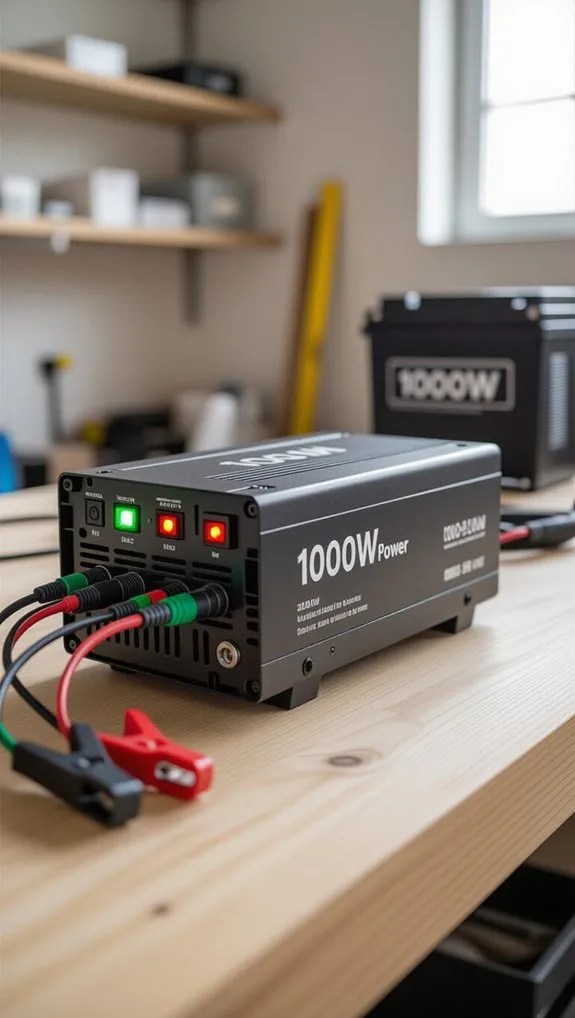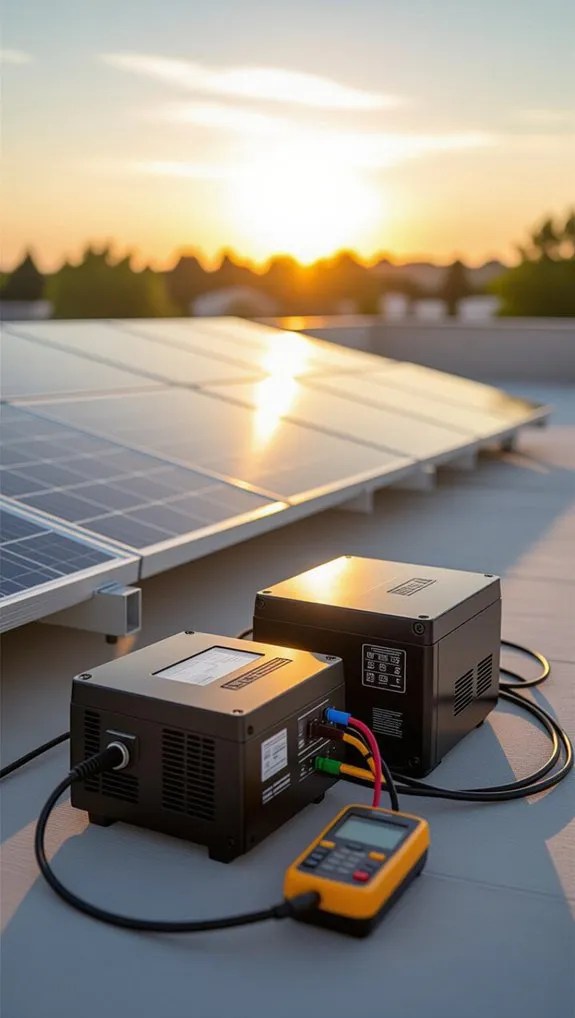If you’re wondering whether a 1000W inverter can charge a 200Ah battery, you’re asking the right question – but you might be surprised by the answer. While it’s technically possible to use an inverter with an AC charger to juice up your battery, it’s far from the most efficient or practical approach you could take.
The truth is, inverters are designed to convert your battery’s DC power into AC power for running household appliances, not the other way around. When you try to reverse this process for charging, you’ll face significant energy losses and potentially put unnecessary stress on your battery system.
In this post, we’ll break down why direct inverter charging isn’t ideal, explore the energy losses you’ll encounter, and share the smart charging methods that will keep your 200Ah battery healthy and performing at its best for years to come.
Can a 1000W inverter charge 200Ah battery

Wondering if a 1000W inverter can charge your 200Ah battery? Not exactly. A 1000W inverter isn’t designed to directly charge batteries. It converts DC to AC for powering appliances, not charging.
While you can use an AC battery charger with the inverter, it’s inefficient due to multiple energy conversions. The inverter’s 90% efficiency means power losses during DC to AC conversion. Charging current depends on the AC charger’s rating, not the inverter’s.
In an ideal scenario, you might recharge a depleted 200Ah battery in about 2.7–3.0 hours, but this method increases wear and energy waste compared to direct DC charging.
What size inverter for 200Ah battery
After exploring why a 1000W inverter can’t directly charge a 200Ah battery, let’s zero in on selecting the right inverter size for your power needs.
For a 12V system, match your 1000W inverter’s voltage to the 200Ah battery. Consider inverter efficiency, continuous rating, and surge capability.
Your 200Ah battery stores 2400Wh, supporting a 1000W inverter drawing ~83–93A.
Critically, size cables and fuses to handle input current safely. Choose an inverter with surge ratings that cover motor startup loads.
If runtime matters, explore parallel batteries or a larger inverter that can handle your specific power requirements without compromising system safety.
How much solar to run inverter

Under the scorching sun or amid unpredictable weather, calculating solar requirements for your 1000W inverter demands precise power planning.
For a 200Ah battery and 1000W inverter, you’ll need a solar array around 2 kW to handle inverter load and battery charging.
Factor in MPPT charge controller efficiency, peak sun hours, and potential charging current losses.
Your system sizing should account for inverter efficiency (around 90%) and include a 20-50% margin for cloudy days.
This approach ensures reliable PV watts and prevents unexpected power interruptions during your RV adventures.
How to safely charge large RV battery
Charging a large RV battery safely requires the right gear, careful connections, and comprehension of proper charge rates. I’ll walk you through selecting the right charger, making secure connections, and implementing critical safety checks to protect your valuable battery investment.
Whether you’re using a dedicated DC charger, an AC charger, or a battery management system, following these steps will help you maintain your battery’s health and performance.
Gear list
When outfitting your RV for reliable battery charging, you’ll want a carefully curated gear list that ensures safe, efficient power management. Your essential components for a 200Ah battery charging setup include:
| Component | Specification | Purpose |
|---|---|---|
| 1000W Pure Sine Wave Inverter | High-efficiency | Power conversion |
| DC Charger | 20-50A | Direct battery charging |
| BMS | Lithium-compatible | Voltage protection |
Select cables with appropriate AWG for your charging current, considering inverter efficiency and power conversion losses. A high-quality DC charger matched to your battery chemistry will optimize charge rates and prevent overheating, ensuring your RV’s electrical system remains robust and reliable.
Connection steps
Safely connect your RV’s 1000W inverter to a 200Ah battery by meticulously following a strategic charging approach.
Verify the 12V system compatibility and ensure your AC charger can handle DC-to-AC-to-DC conversion with minimal inverter efficiency loss.
Carefully size DC current wiring and install an appropriate fuse near the battery to manage the significant amperage draw.
Use a dedicated charge controller to monitor battery state-of-charge and prevent over/under-charging.
Charge rates
After carefully connecting your inverter and battery, grasping proper charge rates becomes the next critical step in maintaining your RV’s power system.
Different battery chemistries demand unique charging approaches for optimal performance and longevity:
- Lithium batteries prefer 0.2–0.5C charge rates (40–100A)
- Lead-acid batteries require gentler C/10–C/5 currents (20–40A)
- Using a 1000W inverter with an AC charger drastically reduces charging efficiency
A 40A DC charger delivers about 480W, recharging a 200Ah battery in roughly 5 hours, compared to 24 hours with a low-efficiency inverter-to-AC charger setup.
Always match your charging method to battery type and monitor temperature for safe, reliable power.
Safety checks
Because charging a large RV battery involves multiple potential risks, mastering safety checks becomes your first line of defense against electrical mishaps and battery damage.
I always verify critical safety elements before charging: check inverter rating compatibility, confirm correct charging voltage, and ensure proper cable sizing.
Fuse protection near the battery positive is non-negotiable.
I recommend using a BMS for overcharge protection and temperature monitoring.
Ventilation is crucial—charge in a dry, well-aired space.
Always perform a careful polarity check, matching positive and negative connections precisely.
These steps prevent potential electrical disasters and protect your valuable battery investment.
Inverter versus charger, key differences explained

While many RV owners might assume an inverter can directly charge a battery, there’s a critical distinction between inverters and battery chargers that’s worth grasping.
Grasping the nuanced roles is crucial for maintaining your 12V 200Ah battery’s health and charging efficiency.
Key differences between inverters and chargers include:
- Inverters convert DC to AC, enabling appliance operation
- Chargers manage complex battery charging stages and current control
- Purpose-built MPPT/DC-DC chargers optimize battery management system functions
An inverter’s continuous power rating doesn’t equate to proper charging capabilities, making dedicated DC chargers essential for reliable battery performance.
What charger size for 200Ah battery
Determine the right charger size for your 200Ah battery by matching its capacity with safe, efficient charging rates.
For a 12V system, lead‑acid batteries need a 20A–40A charger (0.2C), taking 10–12 hours to recharge. LiFePO4 batteries can handle faster 100A (0.5C) charging in about 2 hours, but always check manufacturer specs.
Your charger choice impacts battery life and performance. A multi‑stage charger ensures optimal charging, protecting your battery from overcharge and maximizing longevity.
Whether you’re powering RV systems or off-grid setups, selecting the correct charger size is crucial for reliable energy storage.
Can vehicle alternator help charge battery

If you’re wondering whether your vehicle’s alternator can help charge a 200Ah battery during your RV adventures, you’re asking a smart question that could save you from unexpected power headaches. Your alternator can technically charge the battery, but it’s not straightforward:
- Use a DC-DC or B2B charger to protect both alternator and battery
- Match charging current to battery chemistry (LiFePO4 vs lead-acid)
- Monitor alternator output to prevent overheating
A proper DC-DC charger ensures controlled charging, matching the right charge profile and preventing potential damage from high inrush current or sustained high-amperage charging that could stress your vehicle’s electrical system.
DC to DC chargers for boondocking
After grasping how vehicle alternators can charge batteries, RV owners seeking reliable power solutions during boondocking will find DC-to-DC chargers to be game-changers. These smart devices efficiently convert alternator power to charge your 200Ah battery with minimal losses.
| Charger Type | Charge Current (A) | Charging Time |
|---|---|---|
| Low Output | 20A | 6 hours |
| Medium Output | 30A | 4 hours |
| High Output | 40A | 3 hours |
A quality DC-to-DC charger provides multi-stage charging for lithium or lead-acid batteries, ensuring safe, fast power replenishment while maintaining optimal battery health during your off-grid adventures.
Battery chemistry matters, AGM versus lithium

When choosing between AGM and lithium batteries for your RV power system, grasping their unique characteristics can make a world of difference in your off-grid performance.
Battery chemistry significantly impacts your 1000W inverter and 200Ah battery capabilities:
- LiFePO4 batteries offer deeper discharge (80-100%) and higher charging currents (0.5C-1C)
- AGM batteries require shallower discharge (≤50%) and slower charging (C/10 to C/4)
- Inverter efficiency and charge controller selection dramatically affect battery lifespan
Understanding these differences ensures reliable power, maximizes charging efficiency, and prevents premature battery degradation in your RV electrical system.
Real-world wiring tips and essential protections
Battery chemistry insights from our previous discussion set the stage for comprehending how to safely wire and protect your RV power system.
When running a 1000W inverter with a 200AH battery, choose the right wiring gauge to prevent voltage drop.
Install a DC fuse/circuit breaker rated around 125A near the battery, and implement a battery management system (BMS) with low-voltage cutoff.
Ensure proper ventilation and temperature monitoring for your inverter and battery.
A remote battery gauge will help track continuous current, voltage, and state of charge, keeping your RV’s electrical system reliable and safe.
Frequently Asked Questions
How Long Will a 200AH Battery Last With a 1000W Inverter?
I’d estimate about 1.7 to 2.2 hours of runtime with a 200Ah battery powering a 1000W inverter, depending on battery condition, efficiency losses, and depth of discharge. Real-world performance might be slightly less.
What Size Inverter Do I Need for a 200AH Battery?
I recommend a 1250W inverter for your 200Ah battery. It’ll handle your expected load with a 20-25% margin, ensuring safe operation. Choose a 12V inverter that matches your battery voltage and can manage your continuous power needs efficiently.
How Big of a Battery Do I Need for a 1000 Watt Inverter?
I recommend a 200Ah lithium battery for a 1000W inverter. It’ll provide about 2 hours of runtime at full load. For longer use, consider multiple batteries or scaling up to 600-800Ah for extended power needs.
How Many Watts Do I Need to Charge a 200AH Battery?
I recommend 1200-2400 watts to charge a 200Ah battery efficiently. For routine charging, you’ll want about 240 watts. The key is matching your charger’s output to the battery’s recommended charge rate without exceeding its maximum current.
In Conclusion
Conclusion
So, can a 1000W inverter charge a 200AH battery? The short answer is that while it’s technically possible, it’s not the smart approach. Your 1000W inverter excels at powering appliances and devices, but it’s simply not designed for efficient battery charging. You’ll encounter significant energy losses, inefficient charging cycles, and potential damage to your valuable battery investment.
The better path forward involves using dedicated charging equipment—whether that’s a quality DC charger, MPPT solar charge controller, or shore power charger designed for your specific battery chemistry. Proper charging rates, multi-stage charging profiles, and appropriate safety measures like fusing and temperature monitoring will extend your battery’s lifespan and ensure reliable power for your adventures.
For RV owners looking to maximize their off-grid power setup, pairing the right charging system with efficient appliances makes all the difference. Consider checking out our comprehensive RV refrigerator reviews to explore energy-smart options that work harmoniously with your battery bank, helping you get the most from every amp-hour stored.
